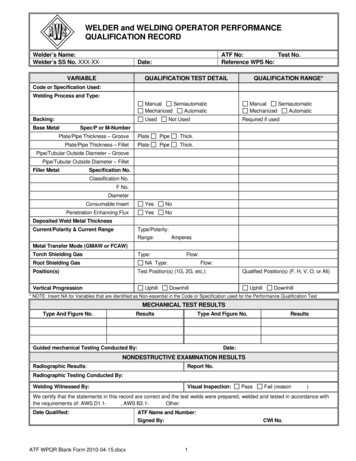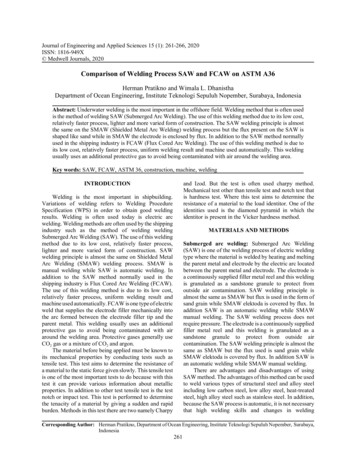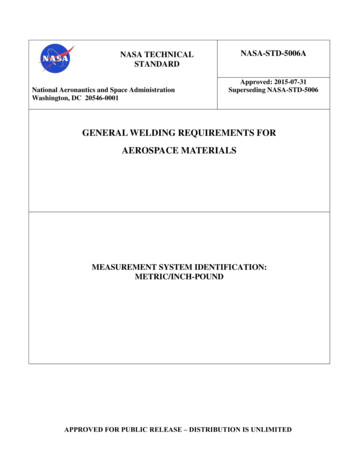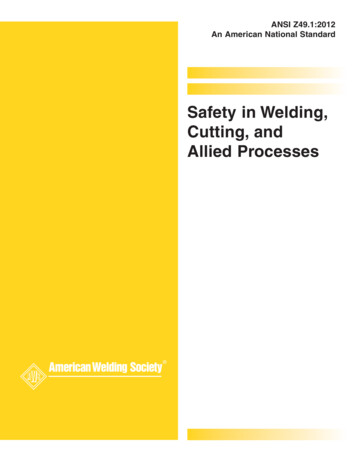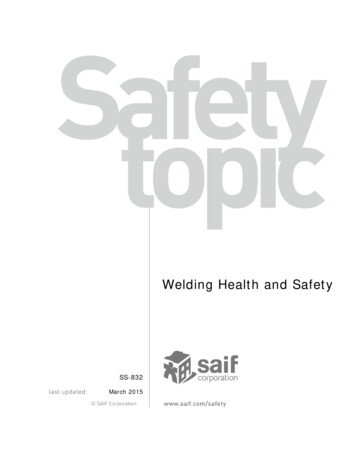
Transcription
Welding Health and SafetySS-832March 2015
Welding Health and SafetyTable of ContentsIntroduction .3What is welding .3Welding and cutting processes .3Types of electrodes .5Health hazards .5Hazard controls .10Special welding situations .12Oxy-fuel gas welding and cutting .12Arc welding and cutting .15Resistance welding .16Appendix A: definitions .17Appendix B: common metals and compounds .18Appendix C: common welding gases .20Resources .20Bibliography .21SS-832 March 2015Page 2
Welding Health and SafetyIntroductionThis guide was written to provide a general understanding of the different welding and cuttingprocesses, the potential health hazards associated with welding and cutting, and a summary ofthe Oregon Occupational Safety and Health Division (Oregon OSHA) regulations, OAR 437Division 2 Subdivision Q: Welding, Cutting and Brazing (1910.251 -. 257).What is weldingThe welding process joins metals together using pressure, heat, flame or electric arc. In thewelding process, a filler metal, and the work piece are heated to form the weld using anelectric arc or combustion gas.Welding and cutting processesThere are more than 80 processes used in welding and cutting. Arc welding is the process inwhich fusion is produced by heating with an electric arc that is generated between anelectrode and the surface of the base metal. Arc cutting is the general process in which thecutting or removal of metals is done by melting with the heat of an arc between anelectrode and base metal. The more common processes are listed below:American Welding Society nomenclatureOther namesShielded Metal Arc Welding (SMAW)Stick rod, stick, coatedelectrode, manualGas Metal Arc Welding (GMAW)Short arc, MIG (metal inert gas),shielded welding, hard wireGas Tungsten Arc Welding (GTAW)Heli-arc, TIG (tungsten inert gas)Flux-core Arc Welding (FCAW)Semi-AutomaticSubmerged Arc Welding (SAW)Sub Arc, Automatic weldingPlasma Arc Cutting (PAC)Plasma cuttingPlasma Arc Welding (PAW)Plasma weldingCarbon Arc Cutting (CAC)Arc Gouging, Air-arcingOxy-acetylene Welding or CuttingTorch welding or cutting,gas welding or cuttingShielded metal arc welding (SMAW) (also known as stick welding) is an arc weldingprocess which produces coalescence by heating with an electric arc between a coveredmetal electrode and the surface of the base metal. Shielding is obtained from decompositionof the electrode covering. Filler metal is obtained from the electrode. The consumableelectrodes usually consist of a low-carbon steel core with a coating of slag-making and gasmaking agents and may include alloying and deoxidizing agents as well.SS-832 March 2015Page 3
Welding Health and SafetyGas metal arc welding (GMAW) or MIG (metal inert gas) welding is an arc weldingprocess wherein coalescence is produced by heating with an arc between a continuous fillermetal electrode (typically a steel alloy wire) and the work. Shielding is obtained entirelyfrom an externally supplied gas mixture. There are four major types of gas metal arcwelding depending on the shielding gas or type of metal transfer that is used. They include:1.Micro-wire using short circuiting transfer and allowing all position welding2.Carbon dioxide using shielding gas of carbon dioxide and larger electrode wire3.Metal inert gas (MIG) using pure inert gas shielding on non-ferrous metals4.Spray using argon/oxygen shielding gasGas tungsten arc welding (GTAW) or TIG (tungsten-inert gas) welding is an arcwelding process wherein coalescence is produced by heating with an arc between a singletungsten electrode and the work. Shielding is obtained from an inert gas or an inert gasmixture. Filler metal may or may not be used. The outstanding features of GTAW welding arethat it will make top quality welds in almost all metals and alloys used in industry andpractically no post weld cleaning is required. The arc and weld pool are clearly visible to thewelder, there is no filler metal across the arc stream, so there is no weld spatter. Welding ispossible in all positions, and there is no slag produced which might be trapped in the weld.Flux cored arc welding (FCAW) is an arc welding process where coalescence is producedby heating with an arc between a continuous filler metal electrode and the work. Shieldingis obtained from a flux contained within the electrode. Additional shielding may or may notbe obtained from an externally supplied gas or gas mixture. The process may be eithersemiautomatic, the most widely used, or automatic.Submerged arc welding (SAW) is an arc welding process which produces coalescence byheating with an arc or arcs between a bare metal electrode or electrodes and the work. Thearc is shielded by a blanket of granular, fusible material on the work. Pressure is not usedand filler metal is obtained from the electrode and sometimes from a supplementarywelding rod. The process may be either automatic or semiautomatic, with the automaticmethod being most widely used. The outstanding features of the submerged arc process arehigh welding speed, high metal deposition rates, deep penetration, smooth weldappearance, good x-ray quality welds, easily removed slag covering, and the ability to joina wide range of material thicknessesPlasma arc cutting is the process in which the metal is cut by melting a localized areawith a constricted arc and removing the molten material with a high velocity jet of hot,ionized gas.Plasma arc welding is an arc welding process similar to gas tungsten arc welding (GTAW).The electric arc is formed between an electrode (which is usually but not always made ofsintered tungsten) and the work piece. The key difference from GTAW is that in PAW, bypositioning the electrode within the body of the torch, the plasma arc can be separated fromthe shielding gas envelope. The plasma is then forced through a fine-bore copper nozzlewhich constricts the arc and the plasma exits the orifice at high velocities (approaching thespeed of sound) and a temperature approaching 20,000 C. Plasma arc welding is anadvancement over the GTAW process. This process uses a non-consumable tungstenelectrode and an arc constricted through a fine-bore copper nozzle. PAW can be used to joinall metals that are weldable with GTAW (i.e., most commercial metals and alloys).SS-832 March 2015Page 4
Welding Health and SafetyCarbon arc cutting “arc gouging” is an arc cutting process in which metals to be cut aremelted by the heat of a carbon arc. The molten metal is removed by a blast of air. This is amethod for cutting or removing metal by melting it with an electric arc and then blowingaway the molten metal with a high velocity jet of compressed air. The air jet is external tothe consumable carbon-graphite electrode. It strikes the molten metal immediately behindthe arc. Air carbon arc cutting and metal removal differ from plasma arc cutting in that theyemploy an open (unconstricted) arc, which is independent of the gas jet.Types of electrodesSolid electrodesSolid electrodes produce less fumes, compared with flux-cored wore or coated electrodes.Fume production is directly related to the amount of consumed electrode. Electrodes areconsumable (composed of steel, cooper, aluminum, various alloys and other metals) ornon-consumable (primarily tungsten).Covered and coated electrodesCovered and coated electrodes are the largest group of electrodes used in welding. Thecovering provides the flux from the weld. Major metals from the coatings include fluoride,nickel, iron, chromium, manganese, copper and molybdenum. Fluoride tends to be themajor component ranging from 10-20% of the fume composition.Bare rods or wireBare rods or wire are immersed in the flux material and fume generation is greatly reduced.Bare rods or wire are typically composed of copper alloys, steel nickel alloys, nickel, orchromium-steel alloys.Health hazardsWelding and cutting processes pose several potential health hazards. The most commonhazards involve exposures to radiation, heat, noise, fumes, gases, and ergonomics. Thefollowing section briefly describes these potential hazards and discusses some protectivemeasures for the specific hazards.RadiationRadiation is a process by which energy is transmitted through space or matter. There aretwo types of radiation associated with welding operations; ionizing and non-ionizing.Ionizing radiation is produced by the electron beam welding process and during the grinding(pointing) of thoriated tungsten electrodes for Gas Tungsten Arc Welding (GTAW) process.To minimize the ionizing radiation exposure from the grinding dust, local exhaust ventilationand respirators should be used.Nonionizing radiation is the more common type of radiation produced by most types ofwelding and includes ultraviolet, infrared, and visible light. Eye injuries are the mostcommon injury sustained by welders because the eyes can be adversely affected by allthree energy ranges (ultraviolet, infrared, and visible light). The skin is principallysusceptible only to the effects of ultraviolet and infrared radiation, and it warns us ofinfrared heat radiation by burning of the skin. Severe erythema or “sunburn” to the skin canincrease the risk of skin cancer for prolonged exposures.SS-832 March 2015Page 5
Welding Health and SafetyIt does not require a long exposure to burn the eyes. The severity depends on the length ofexposure, the intensity of the light source, and the closeness of the eye to the source. Evenbrief exposure to an intense source can cause burns. Inflammation (swelling of the cornea)and eye irritation, also known as flash burns, do not become noticeable for several hours.Application of ice packs will normally relieve the pain, but if it persists, medical attentionshould be obtained. Starring at the blue color of the arc can cause photo chemical changesin the retina, creating permanent loss of vision unless proper protective filters are used.The eyes should be protected from burns, light and heat. Safety glasses and welding hoodsprovide good protection. Safety glasses with side shields would protect from flying sparks,flying chips and flash burns. It is important that all workers wear eye protection whenstanding near a welding operation to prevent arc burns. If a worker is exposed to ultravioletlight, even though the light does not seem intense, burns can occur.Ultraviolet (UV) radiation is generated by all of the arc welding processes. UV radiation candamage the cornea of the eye. Many arc welders are aware of the condition known as“welder’s flash or arc eye or arc flash,” a sensation of sand in the eyes. The medical termfor this condition is photokeratitis and photoconjuctivitis. The arc should never be observedwithout eye protection.Skin exposure to UV can also result in severe burns, in many cases without prior warning.Skin and eye burns from UV exposure can be prevented by the use of proper clothing andeye protection. It is important that welders wear clothing to cover their bare skin and useproper eye protection. Eye protection must meet the filter lens shading requirements of theOSHA regulation for eye and face protection (1910.133). Employers should reference theANSI Z49.1:2012 Guide for Shaded Numbers.Whenever possible, arc welding operations should be isolated so that other workers will notbe exposed to either direct or reflected rays. Working in the proximity of an exposed arcwithout eye protection for a correspondingly longer time can cause arc burn. Walls, ceilingsand other exposed inner surfaces such as booths or rooms should have a dull finishproduced by a non-reflective paint, and provided with portable fire resistant screenssimilarly painted or with fire resistant curtains/screens. The screens should be arranged sothat no serious restriction of ventilation exists. The screens should be mounted so that theyare about 2.0 feet above the floor unless the work is performed at such a low level that thescreen must be extended closer to the floor to protect adjacent workers. The height of thescreen is normally 6.0 feet (1.8 m) but may be higher depending upon the situation.Electromagnetic Fields (EMF)All electric welding processes create EMFs. Although there are studies to date that indicate thereis no evidence of health problems from EMF, it is recommended to protect yourself by: Not placing your body between the welding electrode and work cables. Keeping the welding power source and cables away from you as practical. Don’t coil a welding cable around your body.Persons with a pacemaker should not go near welding or cutting or cutting operationsuntil they have consulted with their doctor because these devices are electrical inoperation and their ability to function can be affected by strong electromagnetic fields.SS-832 March 2015Page 6
Welding Health and SafetyHeatMost people realize that metal with “red heat” temperature can burn the skin. However,material can still cause damage at lower temperatures when it has lost red heat. Inwelding and cutting operations, hot metal is always present and in some cases the metalis preheated to as much as 600 degrees Fahrenheit to improve weldability.Physiological effects of heat are skin burns, hyperthermia and heat stress when the bodytemperature rises to a very high level. Heat problems are usually controlled by acombination of engineering methods, work practices, and personal protective equipment.Some of the common methods are: Use cooling fans to increase the air flow over the worker and increase theevaporative heat loss. The air flow should be across the worker from oneside for optimum control. Use mechanical air conditioning systems in conjunction with the makeup airsystem. Increase the general exhaust ventilation at points of high heat production Supply shielding between the welder and the source of radiant heat, such asa preheated work surface. Allow the welder to have frequent work breaks in a cooler area and to haveplenty of access to cold drinking water.BurnsThe process of welding and cutting produces numerous potential burn hazards. Sparks, hotmetal, spatter, and slag may all cause burns to the welder. It is important that the welderwear appropriate protective gear including dry, hole-free gloves, a heavy shirt, and fulllength cuff-less pants. If the welder is conducting a lot of oxy-acetylene cutting or weldingthat produces molten slag, the welder’s shoes should be covered with spats to prevent theslag from entering the welder’s shoes and causing burns.NoiseNoise problems are not normally associated directly with welding operations except withplasma arc or air carbon arc welding processes. Probably the most common operations thatproduce relatively high noise levels are plasma arc cutting and air carbon arc cutting. Otheroperations associated with many welding operations, such as chipping and grinding, arecommon sources of noise problems.In many cases, excessive noise associated with welding operations cannot be reduced byengineering controls. Therefore, appropriate hearing protection should be used and regularaudiometric tests may be needed to detect the onset of hearing loss.Inhalation hazardsOne of the major health hazards to welders is the inhalation of fumes and gases. The extentof exposure is determined by the exposure time, the concentration, and nature of thecontaminant in the breathing zone. Contamination is normally measured in milligrams percubic meter (mg/m3) of air for particulate matter. For gases, sometimes parts per million(ppm) in air is used.SS-832 March 2015Page 7
Welding Health and SafetyAll of the potential airborne exposures are exacerbated to some degree by smoking.Consequently, smoking in the workplace should be strongly discouraged.FumesFumes are very fine solid particles created by condensation from the gaseous state. Weldingfumes are composed of metals, metal oxides and other compounds volatilized from eitherthe base metal, electrode, or flux material. All welding processes produce fumes, but thequantity can vary widely depending on the process.Welding fume particles are almost all less than one micrometer in diameter so that fumesare present during welding whether a smoke plume is visible or not. Due to their small size,fumes are able to penetrate deep into the respiratory system to the alveoli.The presence of certain toxic metals in fumes may be a more important factor in determiningthe degree of the hazard, than the total quantity of fumes. Metals such as manganese,chromium, nickel, cadmium, zinc, and copper may be present as small fractions of the totalfume, but may represent the major hazard of the job. The major sources of the fume comefrom the electrode metal, flux material and coatings on the base metal. Prolonged and repeatedoverexposure to these metals may potentially cause respiratory and/or neurological problems.Welding fumes have also been classified as “possibly carcinogenic” by the International Agencyfor Research on Cancer (IARC Group 2B).Fume generation rates can be altered by voltage, arc length, current, electrode diameter,electrode polarity, shielding gas, base metal, fluxes, fillers, wire feed speed, humidity, andposition of the weld. As the voltage, arc length, current, wire feed speed, and humidityincreases, more fumes are generated. 30% more fumes are generated by welding DCpositive compared to DC negative or AC.GasesGases are produced in all welding processes. Gasses are produced from the decompositionof the shielding gases and fluxes and from interaction of ultraviolet light or hightemperatures with atmospheric gases and the shielding gas. Ozone, nitrogen oxides andcarbon monoxide are the most common gases formed. Phosgene gas can be produced fromchlorinated solvents decomposing in the welding arc.Phosgene reacts with moisture in the lungs to form hydrochloric acid which is extremelytoxic. To prevent this, solvent use or storage near welding should be prohibited. At theconcentration normally encountered, these gases are not visible to the eye and, in the caseof carbon monoxide, not detectable by smell. Gases are also used for welding processes.The concentration of gases from welding may potentially reach toxic levels in confinedspaces or in areas with little or no ventilation.A regulation addressing these exposures has been adopted by Oregon Occupational Safetyand Health Administration (Oregon OSHA) titled: OAR 437 Division 2 Subdivision Q:Welding, Cutting, and Brazing. Review the Oregon OSHA regulations and follow specificrequirements that pertain to your operations.For a copy of the regulations, follow the link in the References section of this document tothe Oregon Occupational Safety & Health Division’s website.Musculoskeletal injuriesWelding and cutting processes place physical demands on the wrist, elbows, arms,shoulders, neck and back of the welder, due to awkward postures and material handling. Itis recommended that employers evaluate the work area and processes to make sure thatSS-832 March 2015Page 8
Welding Health and Safetyawkward positions are eliminated or greatly reduced. Consider equipment design, productdesign and set-up of the work area during the evaluation.Fire protectionWelding and cutting processes pose a potential fire hazard. These processes should beconducted in areas that are non-combustible or in buildings constructed of non-combustiblematerials. A radius of 35 feet around the welding area should be kept clear of allcombustible material. If the floor is a combustible material, the floor should be kept wetduring the welding or cutting process. Guarding should be used to confine the heat, sparksand slag, and to protect the immovable fire hazards. If welding or cutting is to be done on acontainer that contained flammable or combustible material, thorough cleaning should bedone to ensure that there is no potential for flammable or toxic vapors.As a precautionary measure, fire watchers (designated employees to watch for fire) arerequired when there is a potential for a major fire. Conditions that may require firewatchers include having an appreciable amount of combustible material in buildingconstruction or contents that is closer than 35 feet to the point of operation, having easilyignitable combustible materials more than 35 feet away, or having combustible materialsadjacent to the opposite side of metal partitions, walls, ceilings or roofs that are likely to beignited by conduction or radiation.Fire watchers should be trained on how to use the fire extinguishers that are readilyavailable. They will be in charge of watching for fires during the processes and for a halfhour after the processes concludes, sounding off fire alarms when necessary andextinguishing small controllable fires.Cutting or welding must be permitted only in areas that are or have been made fire safe. Whenwork cannot be moved by practical means, as in most construction work, the area must be madesafe by removing combustibles or protecting combustibles from ignition sources. A hot work planwith permit should be used in areas outside of the normal welding area.Management is responsible for authorizing cutting and welding in the work areas. Prior toauthorization, the area must be inspected and precautions that should be followed be put inwriting. The supervisor should secure authorization for the cutting and welding from themanagement representative.If welding is conducted in a workplace or location that is covered under OSHA’s ProcessSafety Management Standard a hot work permit may need to be issued by managementbefore any welding activities can be conducted.Electrical hazardsElectric shock from welding and cutting equipment can result in severe injuries, burns ordeaths. Serious injuries or deaths can also occur if the electrical shock causes the welder tofall from an elevated location.Employees should be properly trained to observe safe electrical work practices according toOSHA’s Electrical Hazard Training Standard (1910.332). The safe electrical practices shouldinclude: Do not touch live electrical parts Have all installation, operation, maintenance, and repair work done by only byqualified individualsSS-832 March 2015Page 9
Welding Health and Safety Properly install and ground the equipment in accordance with national, state,and local codes Wear dry, insulating gloves in good condition Insulate yourself from the work piece and ground by wearing rubber soledshoes or standing on a dry insulated mat or platform Use fully insulated electrode holders Do not touch holders connected to two welding machines at the same time. Do not use worn, damaged, undersized or poorly spliced cables, welding guncables, or torch cables. Make sure all connections are tight, clean, and dry When using auxiliary power from welding generators, it is recommended thatyou use a circuit protected from a ground fault circuit interrupter (GFCI) Turn off all equipment when not in use. Disconnect the power to equipmentthat will be left unattended or out of serviceHazard controlsSubstitutionSubstitution is considered by using a welding electrode with a less hazardous composition,but without altering welding or metallurgical characteristics. Some manufacturers may havea “low smoke welding wire”, which they claim meets the requirements for a given electrodeclass and generates less fume and smoke compared with the conventional consumable rods.Also substitution may be from using bolts or rivets in place of welding or by using roboticwelding instead of manual welding.VentilationTwo types of ventilation can be used to reduce fume exposures; local exhaust and dilutionventilation. Local exhaust ventilation is the preferred method of ventilation, where thefumes are captured at the source and are removed from the workplace. Dilution ventilationprovides large amounts of air into the workplace to dilute the contaminant. Dilution doesnot remove the contaminant. Fume hoods are not recommended as the fume is generallypassed through the workers breathing zone.Personal protective equipment (PPE)PPE is used to reduce employee exposures to hazards when engineering and administrativecontrols are not feasible or effective in reducing personal exposures. Types of PPE include;respiratory protection, eye protection, skin protection and hearing protection. Additional PPEthat may be required includes hard hats and steel toe boots.Respiratory protectionRespiratory protection is the least desirable method of exposure control from welding fumesand gasses. This exposure control should only be used if exposures cannot be controlledbelow their respective occupational exposure limit through engineering controls. Ifrespiratory protection is used, the employer must follow the OSHA 1910.132 “RespiratoryProtection” standard.To determine what type of respiratory protection is needed, an exposure assessment andPPE assessment must be performed. Once you have collected and reviewed the exposureSS-832 March 2015Page 10
Welding Health and Safetydata, you will be able to determine what your next steps are, which may or may not includerespiratory protection.The types of respiratory protection used by welders for filtering metal fumes and dusts aredisposable single-use NIOSH approved air purifying respirator, half and full-face airpurifying respiratory protection with cartridges, powered air purifying respirators (PAPR)and supplied air respiratory protection.There is a table in the OSHA welding, cutting, and brazing standard 1910.251-.255standard that states the minimum requirements for protective measures, such asrespiratory protection, when welding and cutting are done on some of the more hazardousmetals. The specified metals include manganese, zinc, lead, cadmium, mercury, beryllium,and fluorine compounds. This table should be reviewed to determine your specificrequirements for the processes being conducted at your facility.Eye protectionEye protection is important for welding, cutting and brazing. Helmets or hand shields madeof a material which is an insulator for heat and electricity should be used during all arcwelding or arc cutting operations, excluding submerged arc welding. Flash goggles with sideshields should be worn under the welding helmet or hand shield.Goggles or other suitable eye protection should be used during all gas welding or oxygencutting operations. All operators of resistance welding or resistance brazing equipmentshould use transparent face shields or goggles, depending on the particular job, to protecttheir faces or eyes, as required.OSHA 1910.252 “Welding, Cutting and Brazing: General Requirements”, has the followingtable as a guide for the selection of the proper shade numbers:SS-832 March 2015Page 11
Welding Health and SafetySkin protectionThe worker’s skin should be protected by a double layer of non-flammable clothing orequivalent to prevent burns or other damage by ultraviolet light. All clothing should belaundered regularly to prevent oil and grease buildup. Recommended personal protectiveclothing should include; leather gloves, fire resistant protective sleeves or a fire resistantjacket or a leather apron, and a fire-resistant skull cap under the welding helmet.Hearing protectionHearing protection is recommended when personal time weighted average (TWA) noiseexposures exceed 85 decibels for an 8 hour day and required when noise levels exceed the90 decibels for an 8 hour day or when noise levels exceed the maximum level of 115decibels at any time. Hearing protection can be either ear plugs or ear muffs that have anoise reduction rating. To determine what employees TWA exposures are, personal noisemonitoring is needed. Based on the personal noise exposure results, a company hearingconservation program may be required which would include; audiometric testing, hearingprotection, employee training, and recordkeeping. For more information, see the OregonOSHA 1910.95 “Occupational Noise Exposure” standard.Special welding situationsConfined spacesConfined spaces are generally small or restricted spaces such as a tank, boiler or pressurevessel. All welding and cutting operations done inside of confined spaces must beadequately ventilated to prevent the accumulation of toxic materials or possible oxygendeficiency. Please refer to the OSHA code on confined spaces, OAR 437 Division 2Subdivision J (1910.146).The OSHA regulation for Welding, Cutting and Brazing (1910.251) specifies the ventilation,safety, and respiratory protection requirements for welding operations in confined spaces.Mechanical ventilation must be provided when welding or cutting is done in a space of lessthan 10,000 cubic feet per welder, in a room having a ceiling height of less than 16 feet orin confined spaces or where the welding
Shielded metal arc welding (SMAW) (also known as stick welding) is an arc welding process which produces coalescence by heating with an electric arc between a covered metal electrode and the surface of the base metal. Shielding is obtained from decomposition of the electrode covering. Filler metal is obt


